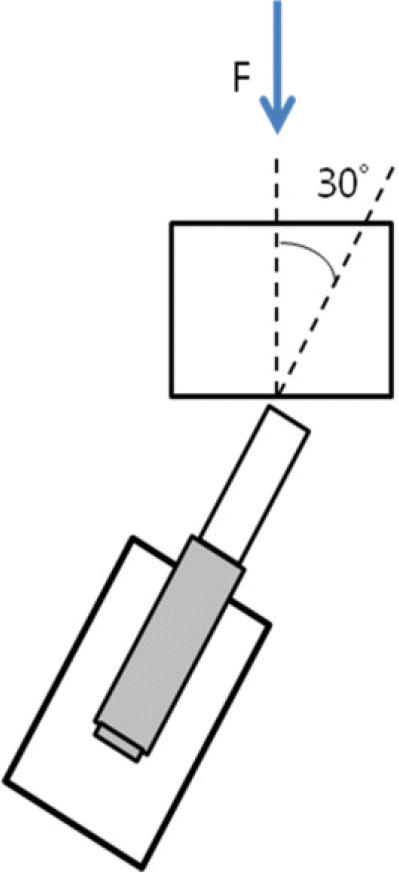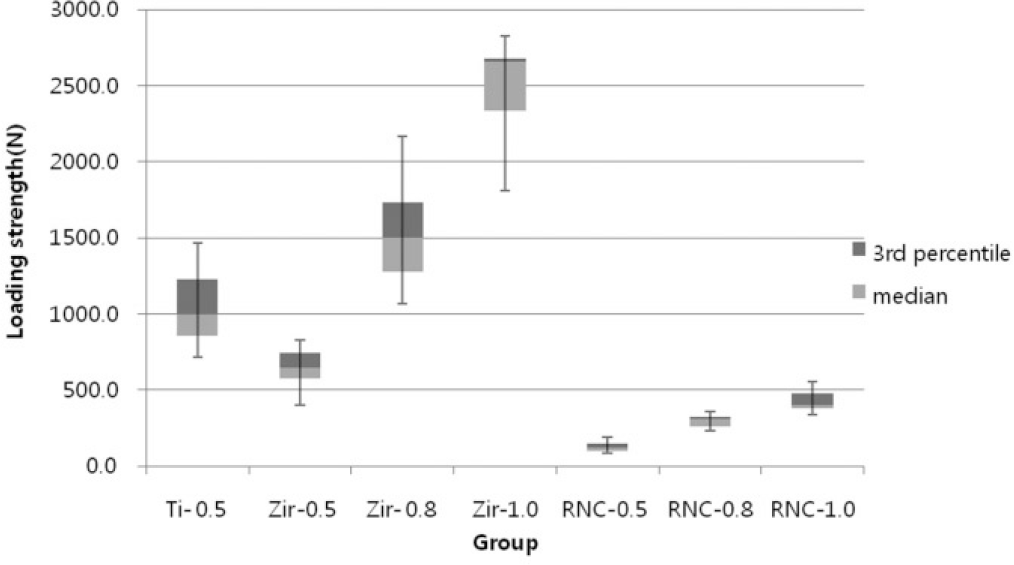Abstract
Purpose
The aim of this in vitro study is to investigate load bearing capacity of esthetic abutments according to the type of material and wall thickness.
Materials and methods
70 specimens equally divided into seven groups according to their abutment wall thicknesses. The abutments prepared with titanium 0.5 mm wall thickness were used as a control group (Ti-0.5), whereas zirconia abutments and resin nano ceramic abutments with wall thickness 0.5 mm, 0.8 mm and 1.0 mm were prepared as test groups (Zir-0.5, Zir-0.8, Zir-1.0 and RNC-0.5, RNC-0.8, RNC-1.0). All specimens were tested in a universal testing machine to evaluate their resistance to fracture and all of them underwent thermocycling before loading test. Mean fracture values of the groups were measured and statistical analyses were made using two-way ANOVA.
Results
Zir-1.0 showed the highest mean strength (2,476.3 ± 342.0 N) and Zir-0.8 (1,518 ± 347.9 N), Ti-0.5 (1,041.8 ± 237.2 N), Zir-0.5 (631.4 ± 149.0 N) were followed. The strengths of RNC groups were significantly lower compared to other two materials (RNC-1.0 427.5 ± 72.1, RNC-0.8 297.9 ± 41.2) and the strengths of all the test groups decreased as the thickness decreases (P < .01). RNC-0.5 (127.4 ± 35.3 N) abutments were weaker than all other groups (P < .05).
Conclusion
All tested zirconia abutments have the potential to withstand the physiologic occlusal forces in anterior and posterior regions. In resin nano ceramic abutments, wall thickness more than 0.8 mm showed the possibility of withstanding the occlusal forces in anterior region. (J Korean Acad Prosthodont 2017;55:144-50)
REFERENCES
1.Manicone PF., Rossi Iommetti P., Raffaelli L. An overview of zirconia ceramics: basic properties and clinical applications. J Dent. 2007. 35:819–26.

2.Henriksson K., Jemt T. Evaluation of custom-made procera ceramic abutments for single-implant tooth replacement: a prospective 1-year follow-up study. Int J Prosthodont. 2003. 16:626–30.
3.Zembic A., Bösch A., Jung RE., Hämmerle CH., Sailer I. Five-year results of a randomized controlled clinical trial comparing zirconia and titanium abutments supporting single-implant crowns in canine and posterior regions. Clin Oral Implants Res. 2013. 24:384–90.

4.Yildirim M., Edelhoff D., Hanisch O., Spiekermann H. Ceramic abutments-a new era in achieving optimal esthetics in implant dentistry. Int J Periodontics Restorative Dent. 2000. 20:81–91.
5.Lüthy H., Wohlwend A., Pietrobon N., Studer R., Tangorra E., Loeffel O. Flexion resistance of a layered integral ceramic system and two reinvested integral ceramic systems. Zahntechnik (Zur). 1990. 47:497–501.
6.Christel P., Meunier A., Heller M., Torre JP., Peille CN. Mechanical properties and short-term in-vivo evaluation of yttrium-oxide-partially-stabilized zirconia. J Biomed Mater Res. 1989. 23:45–61.
7.Glauser R., Sailer I., Wohlwend A., Studer S., Schibli M., Schärer P. Experimental zirconia abutments for implant-supported single-tooth restorations in esthetically demanding regions: 4-year results of a prospective clinical study. Int J Prosthodont. 2004. 17:285–90.
8.Yildirim M., Fischer H., Marx R., Edelhoff D. In vivo fracture resistance of implant-supported all-ceramic restorations. J Prosthet Dent. 2003. 90:325–31.

9.Adatia ND., Bayne SC., Cooper LF., Thompson JY. Fracture resistance of yttria-stabilized zirconia dental implant abutments. J Prosthodont. 2009. 18:17–22.

10.Att W., Yajima ND., Wolkewitz M., Witkowski S., Strub JR. Influence of preparation and wall thickness on the resistance to fracture of zirconia implant abutments. Clin Implant Dent Relat Res. 2012. 14:e196–203.

11.Koller M., Arnetzl GV., Holly L., Arnetzl G. Lava ultimate resin nano ceramic for CAD/CAM: customization case study. Int J Comput Dent. 2012. 15:159–64.
12.Dixon DL., Breeding LC., Sadler JP., McKay ML. Comparison of screw loosening, rotation, and deflection among three implant designs. J Prosthet Dent. 1995. 74:270–8.

13.Strub JR., Gerds T. Fracture strength and failure mode of five different single-tooth implant-abutment combinations. Int J Prosthodont. 2003. 16:167–71.
14.Waltimo A., Kemppainen P., Könönen M. Maximal contraction force and endurance of human jaw-closing muscles in isometric clenching. Scand J Dent Res. 1993. 101:416–21.

15.Waltimo A., Könönen M. A novel bite force recorder and maximal isometric bite force values for healthy young adults. Scand J Dent Res. 1993. 101:171–5.

16.Gehrke P., Dhom G., Brunner J., Wolf D., Degidi M., Piattelli A. Zirconium implant abutments: fracture strength and influence of cyclic loading on retaining-screw loosening. Quintessence Int. 2006. 37:19–26.
17.Helkimo E., Carlsson GE., Helkimo M. Bite force and state of dentition. Acta Odontol Scand. 1977. 35:297–303.

18.Butz F., Heydecke G., Okutan M., Strub JR. Survival rate, fracture strength and failure mode of ceramic implant abutments after chewing simulation. J Oral Rehabil. 2005. 32:838–43.

19.Zembic A., Sailer I., Jung RE., Hämmerle CH. Randomized-controlled clinical trial of customized zirconia and titanium implant abutments for single-tooth implants in canine and posterior regions: 3-year results. Clin Oral Implants Res. 2009. 20:802–8.

20.Sailer I., Sailer T., Stawarczyk B., Jung RE., Hämmerle CH. In vitro study of the influence of the type of connection on the fracture load of zirconia abutments with internal and external implant-abutment connections. Int J Oral Maxillofac Implants. 2009. 24:850–8.
21.Hjerppe J., Lassila LV., Rakkolainen T., Narhi T., Vallittu PK. Load-bearing capacity of custom-made versus prefabricated commercially available zirconia abutments. Int J Oral Maxillofac Implants. 2011. 26:132–8.




 PDF
PDF ePub
ePub Citation
Citation Print
Print




 XML Download
XML Download